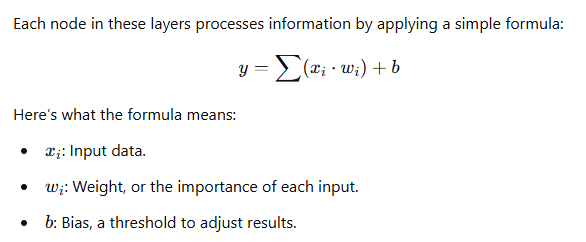Understanding Neural Networks: A Beginner’s Guide
Neural networks are the backbone of modern artificial intelligence (AI), powering innovations from image recognition to language translation. If you’ve ever wondered how AI systems “think,” neural networks are the answer. Let’s explore this fascinating topic step by step, from their structure and history to how they’re shaping our world today.
What Are Neural Networks?
At their core, neural networks are computational models inspired by the human brain. Just as our brain uses neurons to process information, neural networks use nodes (or artificial neurons) to analyze data and make decisions. These networks are called artificial neural networks (ANNs) to distinguish them from biological ones.
How Do Neural Networks Work?
Think of a neural network as a series of layers:
- Input Layer: This is where the network receives data (like a photo or a set of numbers).
- Hidden Layers: These layers perform complex computations to identify patterns.
- Output Layer: This layer delivers the final result, like classifying an image as “cat” or “dog.”
A Simple Prototype Example

The Journey of Neural Networks: From Prototypes to Powerhouses
1. Early Prototypes
Neural networks began as simple models:
- 1943: Warren McCulloch and Walter Pitts introduced the idea of artificial neurons.
- 1958: Frank Rosenblatt created the perceptron, a basic neural network capable of binary classification (e.g., yes/no decisions).
2. The Backpropagation Breakthrough
In the 1980s, researchers discovered backpropagation, an algorithm that allowed networks to adjust their weights based on errors. This made neural networks much more powerful.
3. The GPU Revolution
By the late 1990s, NVIDIA’s GPUs (graphics processing units) enabled neural networks to process massive amounts of data quickly. This led to breakthroughs like AlexNet (2012), which revolutionized image recognition.
Types of Neural Networks
Neural networks come in various forms, each designed for specific tasks:
- Feedforward Neural Networks (FNNs):
- Data flows in one direction, from input to output.
- Used for basic tasks like prediction.
- Convolutional Neural Networks (CNNs):
- Excellent for analyzing images.
- Example: Detecting objects in photos.
- Recurrent Neural Networks (RNNs):
- Designed for sequential data like text or time series.
- Example: Predicting stock prices or writing text.
- Generative Adversarial Networks (GANs):
- Consist of two networks: a generator and a discriminator.
- Example: Creating realistic fake images or videos.
- Transformers:
- Powerhouse models like OpenAI’s GPT-4.
- Handle complex tasks like language translation and text generation.
Training Neural Networks: Learning from Data
Neural networks learn by analyzing data and improving over time:
- Training:
- The network uses labeled data to understand patterns.
- Example: Feeding the network thousands of cat and dog photos to classify them correctly.
- Optimization:
- The network minimizes errors using algorithms like gradient descent.
- This process adjusts weights and biases to make the model more accurate.
- Evaluation:
- The model’s performance is measured using a cost function, which quantifies errors.
Real-World Applications
Neural networks are transforming industries:
- Healthcare:
- Analyzing medical images to detect diseases like cancer.
- Personalizing treatments based on patient data.
- Self-Driving Cars:
- NVIDIA’s Drive AGX uses neural networks to process sensor data and navigate roads.
- Finance:
- Predicting stock trends and detecting fraudulent transactions.
- Entertainment:
- Powering recommendation systems on platforms like Netflix and YouTube.
The Future of Neural Networks
The next frontier includes:
- Physical AI: Training robots to interact with the physical world using NVIDIA Cosmos.
- Personal AI Assistants: More intuitive and personalized digital helpers.
- Democratization of AI: Making neural network technology accessible to everyone, from researchers to hobbyists.
Conclusion
Neural networks are more than just a technological marvel—they’re a bridge to the future, helping us solve problems once thought insurmountable. From early prototypes to today’s advanced systems, their journey reflects the limitless potential of AI.
By understanding the basics of neural networks, you’re not just learning about a tool—you’re glimpsing the foundations of tomorrow’s innovations.
